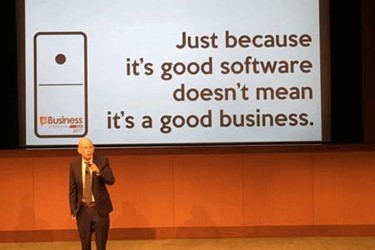Software Wisdom From Seth Godin

By Abby Sorensen, Editor

Speaker and author Seth Godin is the author of 18 books, including Tribes, which was on the Amazon, New York Times, BusinessWeek and Wall Street Journal bestseller lists. To his raving fans, Godin needs no introduction. To the average software developer who doesn’t religiously read his blog, one of the most popular in the world, it’s important to understand the marketing guru knows the ins and outs of software businesses. Godin has spent more than 30 years developing, marketing, and selling software. His first job out of college was as a brand manager at an education software company. He was then an independent developer before founding a commercial email software company that eventually sold to Yahoo! (where Godin was VP of Direct Marketing for a short time).
Godin spoke at the Business of Software conference in September 2017 for nearly two hours. He spent the first half of his presentation sharing insights from three decades in the software businesses, and the second half was spent fielding audience questions about software marketing best practices. Here are some of the best quotes and takeaways from Godin’s session:
- “Just because it’s good software doesn’t mean it’s a good business.” Ask yourself, “Has someone else sold software something like this for a price close to mine?” If the answer is no, you’re either in for an uphill battle, or you’re looking at a bad business idea.
- In B2B software, your job is not to increase joy, it’s to reduce fear. The biggest question your customers are asking themselves about buying your software is, “What will I tell my boss?” Make your customer fear the pain of not implementing your software.
- Instead of a minimum viable product, focus on building a minimum viable audience. Find the smallest group of people to get your software started, and get them to the point where those customers can’t live without you. Find the smallest viable group of disaffected nerds and delight them so much that they need you. Then you make it easy for them to talk about your software.
- There are three reasons software should be free (and those reasons are not related to cost). Free software should either earn permission to talk to people, get people hooked, or help spread the word so they’ll upgrade to a paid version.
- If your software is created for geeks and by geeks, it will get stuck. The geeks won’t want it to spread to their bosses. Slack’s rapid growth was partly because the geeks had an easy way to show peers how to use it and an incentive to share it.
- Engineers think software speakers for itself, but nothing speaks for itself. Your brand is what speaks for your software. For example, when Google was first competing with Bing, every engineer liked Google more. Then someone ran a test where they transposed the two logos, so that Bing’s search results appeared under the Google logo. During that test, every engineer still picked Google because of its brand power.
- Software that works is a commodity now, software that means something is different. Your software support needs to be easy, automatic, onshore, and equal to the quality of the software you are building.
- Just because software scales to “infinity” doesn’t mean you need “infinity” customers. Maybe you only need 1,000 customers. Fire those customers who don’t want to pay your price or who cause too many problems.
- The difference between $3,000 software and $30,000 software is that the $30,000 software comes with $27,000 worth of purchasing decision making meetings. Be sure to account for this in your sales cycle when you build out you pricing model. Charge more than competitors, and be proud of it because it should mean you provide even more value for your software.
- Your biggest asset shouldn’t be your code base; it should be your happy customers.
